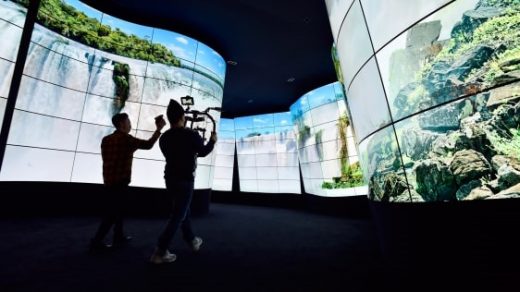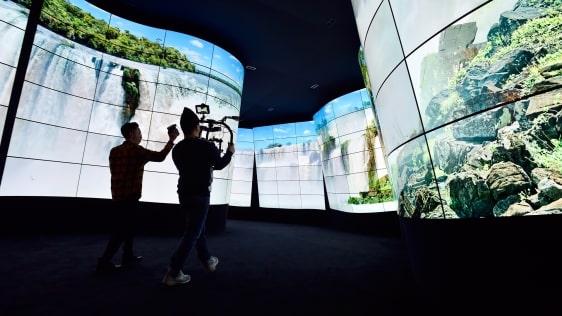CES Could (And Should) Go Virtual Within The Next Decade
Last week I was in Las Vegas to attend my 43rd CES. With 2.5 million square feet of exhibit space and more than 180,000 people attending, the show is one of the largest trade shows in the world. And for most of us in tech, there are plenty of reasons to attend—from meeting with clients and potential clients and checking out key products in person.
I’m able to pre-select products that interest me because, as a member of the analyst and press community, I received over 2,500 meeting requests before the show started. The requests began showing up in my email in early September. While I can’t read all of them, I scan the subject lines looking for products of interest. When I find them, I put them on a watch list.
But my time in Las Vegas is pretty much taken up by meetings. That left 30 minutes to visit the convention center’s exhibit hall, and 90 minutes to check out the exhibits at the Sands.
The show is so expansive now with exhibits placed in two major venues and six satellite hotels. It’s diversified and grown into much more than consumer electronics show. Even if I spent 100% of my time on the show floors, I couldn’t have seen it all during the four days of the show. And it’s hard to get around inside the exhibit halls. At any given time at least 75-80% of the show’s 180,000 attendees are packing the aisles. As I tried to walk the aisles at LVCC, a quip by Yogi Berra—”it’s so crowded nobody goes there anymore”— kept ringing in my ears.
For these reasons, I think CES and other trade shows will eventually go virtual. The virtual trade show concept has been around for some time but the technology hasn’t been available to approximate the experience of a real trade show in VR.
That’s changing. Thanks to virtual reality goggles and platforms like Oculus, Vive and others in the works, I could envision that within the next 6-8 years, it may be possible for any vendor to create a VR-based 360-degree exhibit where anyone could experience products as if they were at a real trade show.
Imagine a virtual CES. Using VR glasses, you would be able to walk through LG’s video canyon as thousands of us did at CES and marvel at the technology behind it. You could stand in front of Sony’s new 146-inch 8K TV and run through a demo.
Videoconference systems such as Zoom and Skype video could be used for the human interactions and meetings that happen at real trade show booths. While viewing the exhibit though VR glasses, a representative from the company could be doing the demo as if they were standing next to you at the show.
Vendors might use a common set of VR tools and 3D cameras to create exhibits that would work with all VR glasses. The exhibits could be tied to a virtual show, or the vendor could just create a special exhibit that they use and update as they launch new products.
The economic implications of this are interesting. If you were at CES and saw the huge exhibits from companies like Sony, Samsung, and LG you might have wondered how much they cost. Just creating the giant exhibits (and staffing them) can run well over $5 million for a company, and that number may be conservative. Add the booth space rental costs, hotels, and travel expenses and soon exhibiting at CES becomes a major line item for even the biggest tech companies.
Meanwhile, the cost of creating a virtual exhibit is probably less than a fifth of the cost of a “real” exhibit. And a VR exhibit could easily be accessed by far more people than just the 180,000 in a large physical structure in Las Vegas. Vendors would be less dependent on the tech media at CES to get the word out about new products. People could experience them virtually, as if they too were in Vegas.
I became convinced that the idea of virtual or VR-based trade shows was in our future after I was shown how Cirque Du Soleil used VR to put the user on a virtual stage to watch the show happening around them. The acts happen just a few feet away from your virtual seat. You can view it on Samsung’s Gear platform or on Google’s Daydream. My mind wandered from that (entertainment) concept over to the idea of virtual product reviews and how that might impact trade shows in the future.
Of course, virtual trade shows, if done well, could end up taking business away from physical convention centers and hotels. Real-world shows in general could eventually become less important.
It probably won’t happen anytime soon. VR headsets are not close to being prime-time products for consumers. But after seeing the demo of HTC’s Vive Pro and the vivid VR content it can deliver, I am convinced that the time will eventually come. Even as augmented reality technology supplants VR tech in many use cases, virtual trade shows could become VR’s killer app.
Each year I leave CES I say that this will be my last. It takes a toll on my body: Every day I walked close to 10 miles to get to events, meetings, and exhibits held at different venues around the sprawling Vegas Strip. Personally I’d prefer to see products in VR than deal with the hassle and expense of CES, which arguably has grown too large for the physical world.
Fast Company , Read Full Story
(10)



